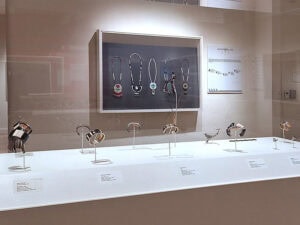
For further recent publications about Robert Smit, you can read Liesbeth den Besten’s article in Metalsmith, v.33, n.5, 2013, and the catalog published by Padova, Musei Civici agli Eremitani, on the occasion of this year’s show, called Esoteric Revelations.
Susan Cummins: Congratulations! You were just awarded the Golden Ring of Honor 2014 by the Association for Goldsmiths’ Art in Hanau, Germany. This recognition is a great honor. What is the history of this 41 year-long tradition? And how do you feel about getting it?
Robert Smit: The tradition was started in 1933, so it is already 81 years old! In the beginning, the Golden Ring of Honor was given every year up until 1957. In 1960 it was changed to every 3 years. The first years it took place in Berlin. Then in 1947 it moved to Hamburg, because the Gesellschaft für Goldschmiedekunst had to move out from Berlin. For the last 29 years, the meetings and presentations of the award have taken place in Hanau. See the list of Ehrenringträger (Carriers of the honorary ring) at the end of the interview.
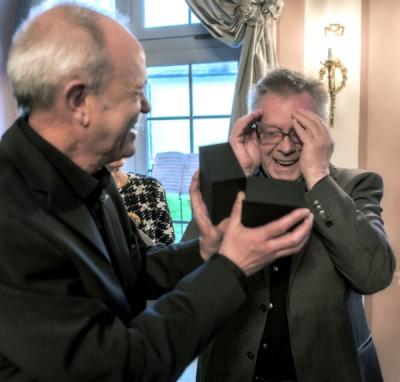
For further recent publications about Robert Smit, you can read Liesbeth den Besten’s article in Metalsmith, v.33, n.5, 2013, and the catalog published by Padova, Musei Civici agli Eremitani, on the occasion of this year’s show, called Esoteric Revelations.
Susan Cummins: Congratulations! You were just awarded the Golden Ring of Honor 2014 by the Association for Goldsmiths’ Art in Hanau, Germany. This recognition is a great honor. What is the history of this 41 year-long tradition? And how do you feel about getting it?
Robert Smit: The tradition was started in 1933, so it is already 81 years old! In the beginning, the Golden Ring of Honor was given every year up until 1957. In 1960 it was changed to every 3 years. The first years it took place in Berlin. Then in 1947 it moved to Hamburg, because the Gesellschaft für Goldschmiedekunst had to move out from Berlin. For the last 29 years, the meetings and presentations of the award have taken place in Hanau. See the list of Ehrenringträger (Carriers of the honorary ring) at the end of the interview.
And how do you feel about getting it?
Robert Smit: I first experienced the excitement of this award as a student at the Kunst- und Werkschule in Pforzheim when it was announced that Max Fröhlich won (1965). With this international distinction I find myself in the company of excellent jewelry designers. It gives me the highest form of recognition in my field.
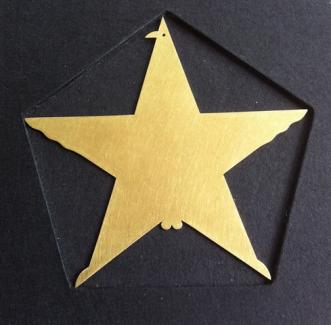
You are quoted as saying, “I think I have become too much encapsulated in jewelry. I want to have it in balance, drawing and jewelry—they are so close to each other.” Can you explain this? How does this idea affect your work?
Robert Smit: The quality of a piece of jewelry is never related to its functionality. The challenge is in imagining what an ornament can be. Jewelry is an object that transcends utility. The essence of my work is just part of my way of thinking and doing. It is my personal history that leads to choices I make. I make no distinction in whether it’s a drawing or a piece of jewelry. Therefore, they are close to each other.

Robert Smit: In 1966 I graduated cum laude from the Kunst- und Werkschule and then went back to my hometown of Delft and opened my studio.
What were your early inspirations?
Robert Smit: The works of Jan Schoonhoven (Zero), including his drawings, his reliefs, and his ideas, rather strongly influenced me. Also the works of Piero Manzoni (Zero) and the works from the Arte Povera movement were important.
Back in the 1960s and 70s you were involved in disputes about the use of gold in jewelry. How are you feeling about that now? What is your opinion about how the field is using it today?
Robert Smit: At that time I was against the current idea of the democratization of the jewel. In my opinion, this was a gigantic dumbing down, an unbridled levity, where the essence of the jewel got lost. My use of gold was partly a way to take a position against this dumbing down, a position that could counteract this development. The brouhaha that this brought about in the Netherlands indicates that this was an exciting time. However, soon after 1985, “The Ban on Gold” was a thing of the past! Working with gold was no longer “forbidden.”
The level of knowledge and handling of materials depends on your education, training, and the school you attend, and is ultimately measured by the design. This applies to all materials and visions. If you want to deal with metal and you want to create jewelry, go to the Zeichen Academie in Hanau, where you will learn how to make gold alloy and how to hold a hammer in 7 semesters. And also where you can learn the most modern techniques. After this academy, continue to further your education at someplace like the Rietveld Academie, the Academie der Bildenden Künste in Münich, or any other academy anywhere in the world. That seems the way to do it to me.
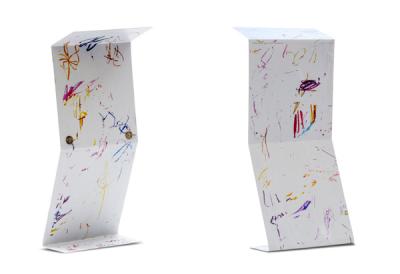
Robert Smit: Here is what I wrote about it in the catalog Madonna delle Dolomiti, Galerie Louise Smit, 2006:
“Madonna delle Dolomiti
In August 1980 I heard her sing.
A cappella.
We were on our way to Amsterdam, coming from Venice.
I was driving, somewhere along route 242, between S.Cristina and S.Pietro.
It was night and the sound was coming from the car radio.
An Italian yodel of the most exquisite kind.
The quality of her voice was beyond all comparison.
Even if I had been able to understand the language, the lyrics would not have mattered at all, their significance being absolutely secondary to her voice.
The meaning of the song for me consisted in the sounds.
These sounds and intonations produced an unprecedented sense of enchantment.
When the song was over, I believed myself to be in heaven.
This moment of beauty and enlightenment has never left me since.
In my current work, I search for the equivalent of a similar kind of purity and excitement.
My fellow passengers, Wim, Karel, and Kees, were asleep when she was singing, so that the sound of her voice was mine alone. When I, all excited, told them about this experience of sheer bliss afterwards, they looked at me incredulously.”
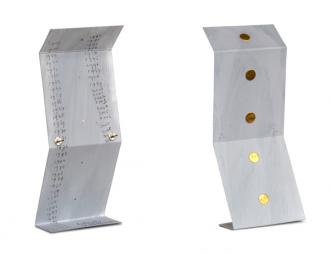
What have you seen, heard, or read recently that you could recommend?
Robert Smit: A year and a half ago I saw a beautiful exhibition by Beatrice Brovia at Galerie Caroline van Hoek in Brussels. It impressed me, so I looked further at her work. This also brought me in contact with the works of Nicolas Cheng, who she works with. Last year in Amsterdam I saw their work at Sieraad Fair, and then last March at Schmuck we met again and we spoke about their work. I was glad to be able to invite them to show their work at the fine art Galerie De Zaal in Delft, where I will also exhibit my work in the same exhibition starting November 1, 2014. Jon Stam, who is an excellent young designer, will join us there as well.
Thank you.
Golden Ring Honorees
|
1933 |
Franz Rickert |
München |
|
1934 |
Emil Lettré |
Berlin |
|
1935 |
Josef Pöhlmann |
Nürnberg |
|
1936 |
Ludwig Riffelmacher |
Berlin |
|
1937 |
Johann Michael Wilm |
München |
|
1938 |
Elisabeth Treskow |
Köln |
|
1939 |
Karl Borromäus Berthold |
Köln |
|
1940 |
Ferdinand Richard Wilm |
Berlin |
|
1941 |
Julius Maria Schneider |
München / Schwaz in Tirol |
|
1942 |
August Bock |
Hanau |
|
1943 |
Herbert Zeitner |
Lüneburg |
|
1944 |
Fritz Möhler |
Schwäbisch Gmünd |
|
1946 |
Theodor Wende |
Pforzheim |
|
1947 |
Alexander Schönauer |
Hamburg |
|
1948 |
Hermann Wandinger |
Dorfen |
|
1949 |
Martin Seitz |
Passau |
|
1950 |
Josef Arnold |
Hamburg |
|
1951 |
Baron Erik Fleming |
Stockholm, Schweden |
|
1952 |
Meinrad Burch-Korrodi |
Zürich, Schweiz |
|
1953 |
Jan-Eloy Brom |
Utrecht, Niederlande |
|
1954 |
Max Olofs |
München |
|
1955 |
Sigurd Persson |
Stockholm, Schweden |
|
1956 |
Lili Schultz |
Halle |
|
1957 |
Walter Lochmüller |
Schwäbisch Gmünd |
|
1960 |
Bertel Gardberg |
Skuru, Finnland |
|
1963 |
Sören Georg Jensen |
Kopenhagen, Dänemark |
|
1965 |
Max Fröhlich |
Zürich, Schweiz |
|
1969 |
Hermann Jünger |
Pöring bei München |
|
1972 |
Friedrich Becker |
Düsseldorf |
|
1975 |
Mario Pinton |
Padua, Italien |
|
1978 |
Ebbe Weiß-Weingart |
Salem |
|
1982 |
Karl Gustav Hansen |
Kolding, Dänemark; Grandvaux, Schweiz |
|
1985 |
Bruno Martinazzi |
Turin, Italien |
|
1990 |
Anton Cepka |
Sväty Jur, Slowakei |
|
1994 |
Yasuki Hiramatsu |
Tokyo, Japan |
|
1998 |
Giampaolo Babetto |
Arquà Tetrarca, Italien |
|
2002 |
Michael Rowe |
London, Großbritannien |
|
2005 |
Peter Skubic |
St. Michael, Österreich |
|
2008 |
Tone Vigeland |
Oslo, Norwegen |
|
2011 |
Otto Künzli |
München |




